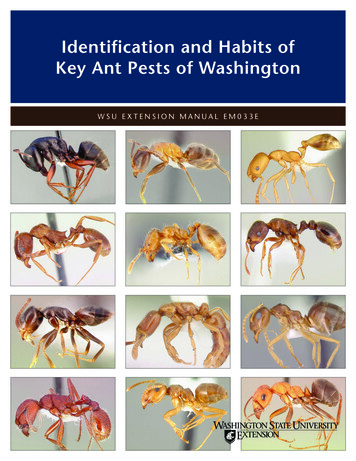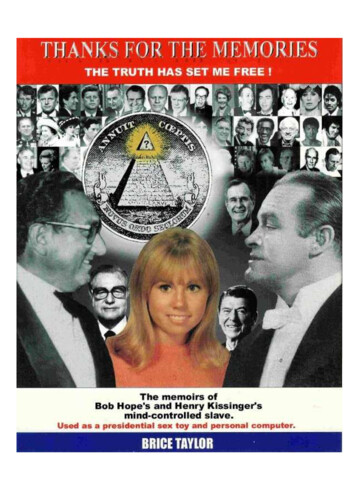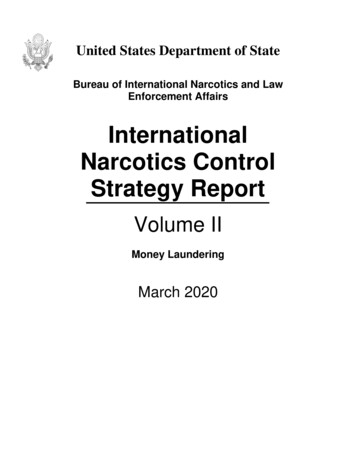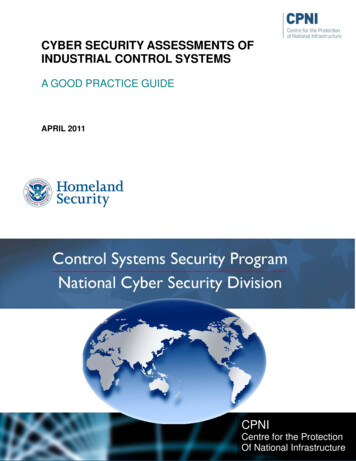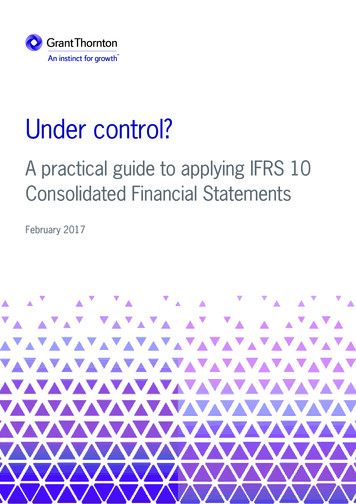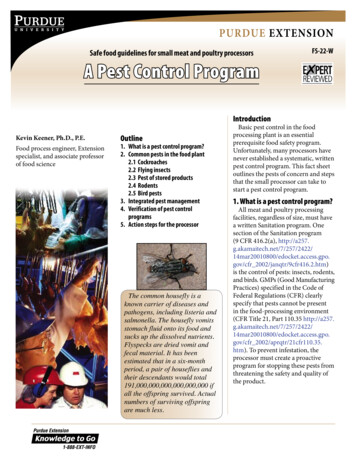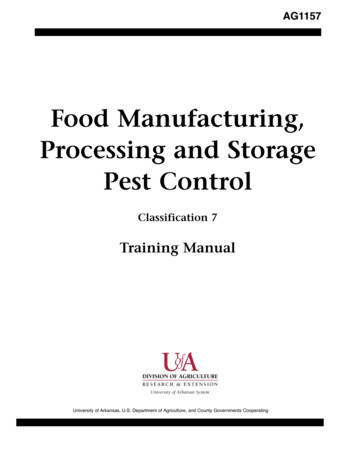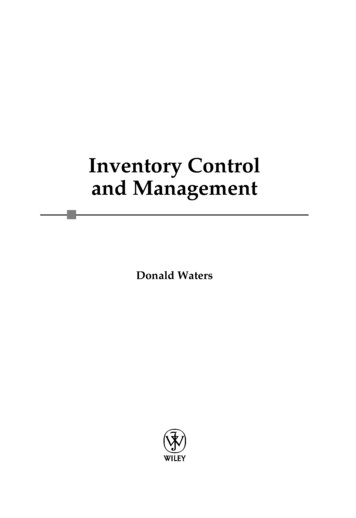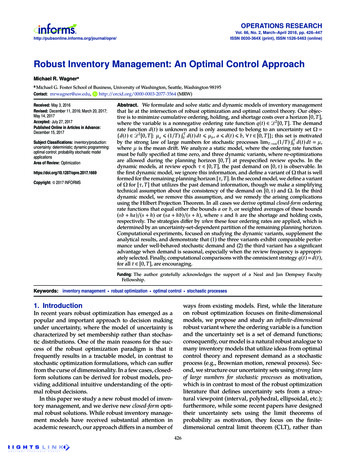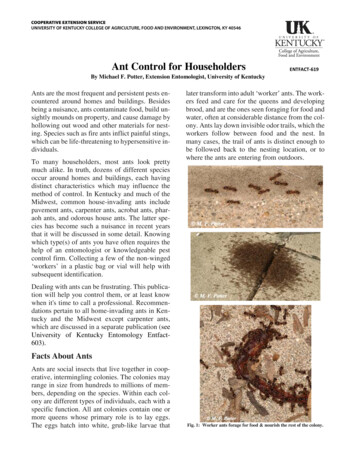
Transcription
Ant Control for HouseholdersENTFACT-619By Michael F. Potter, Extension Entomologist, University of KentuckyAnts are the most frequent and persistent pests encountered around homes and buildings. Besidesbeing a nuisance, ants contaminate food, build unsightly mounds on property, and cause damage byhollowing out wood and other materials for nesting. Species such as fire ants inflict painful stings,which can be life-threatening to hypersensitive individuals.To many householders, most ants look prettymuch alike. In truth, dozens of different speciesoccur around homes and buildings, each havingdistinct characteristics which may influence themethod of control. In Kentucky and much of theMidwest, common house-invading ants includepavement ants, carpenter ants, acrobat ants, pharaoh ants, and odorous house ants. The latter species has become such a nuisance in recent yearsthat it will be discussed in some detail. Knowingwhich type(s) of ants you have often requires thehelp of an entomologist or knowledgeable pestcontrol firm. Collecting a few of the non-winged‘workers’ in a plastic bag or vial will help withsubsequent identification.later transform into adult ‘worker’ ants. The workers feed and care for the queens and developingbrood, and are the ones seen foraging for food andwater, often at considerable distance from the colony. Ants lay down invisible odor trails, which theworkers follow between food and the nest. Inmany cases, the trail of ants is distinct enough tobe followed back to the nesting location, or towhere the ants are entering from outdoors.Dealing with ants can be frustrating. This publication will help you control them, or at least knowwhen it's time to call a professional. Recommendations pertain to all home-invading ants in Kentucky and the Midwest except carpenter ants,which are discussed in a separate publication (seeUniversity of Kentucky Entomology Entfact603).Facts About AntsAnts are social insects that live together in cooperative, intermingling colonies. The colonies mayrange in size from hundreds to millions of members, depending on the species. Within each colony are different types of individuals, each with aspecific function. All ant colonies contain one ormore queens whose primary role is to lay eggs.The eggs hatch into white, grub-like larvae thatFig. 1: Worker ants forage for food & nourish the rest of the colony.
At certain times of the year, ant colonies producelarge numbers of winged individuals known as‘swarmers.’ These winged ants emerge from thenest to mate and establish new colonies. When aswarm of ants emerges indoors, it's an indicationthat a nest is present. Fortunately, the likelihoodof swarmers establishing a new colony inside abuilding is low. Nonetheless, an exodus of wingedants appearing indoors can be disturbing, and isoften mistaken for termites.Fig. 2b: Appearance of winged ants (left) versus winged termites(right). Note the pinched waist and elbowed antennae on the ant.Winged ants can be distinguished from termitesby comparing certain features. Ants have a narrow(pinched) waist similar to wasps, whereas termitesare virtually the same width from end to end. Antsand termites each have four wings; however, onants the front wings are longer than the hind wingswhile on termites all four wings are of equal sizeand length. Finally, the antennae of ants are bentor "elbowed" whereas termite antennae arestraight.Ants build their nests in many different locationsboth inside and outside of buildings. Species nesting inside, or foraging indoors for food or moisture, tend to be the most challenging to control.Ant EliminationThe mistake most people make when attemptingto control ants is only spraying the ones they see.This approach usually fails because the ants seenforaging over exposed surfaces is only a smallportion of the colony. Typically, there will bethousands of additional ants (including one ormore egg-laying queens) hidden somewhere in anest. Eliminating queens and other colony members within nests is often the key to effective antcontrol.Ants Nesting Indoors. Buildings contain many favorable nesting locations for ants. Preferred sitesinclude spaces behind walls, cabinets, and appliances; behind door and window frames; and underfloors and concrete slabs. Most of these nestingareas are hidden, making it hard to pinpoint theirlocation. When the whereabouts of a nest can’t bedetermined, or is inaccessible, insecticide baits areusually a good option, especially for householders.Ant baits contain a food attractant combined witha slow-acting insecticide. Upon discovery, foraging ants transport the bait back to the nest and feedit to the queen(s) and other colony members. As aresult, the entire colony can be destroyed. Severaleffective ant baits are sold in stores and online.Some come in pre-filled plastic stations (about thesize of a cookie), while others come in a plastictube or syringe. Often formulated as gels, thesqueezable/syringe-type baits are often the mostFig. 2a: Winged ants (above) versus winged termites (below).2
of ants in the colony declines. Continue to placeadditional baits wherever ants are seen.versatile and effective. Popular consumer brandsinclude Combat, Raid, Ortho, and Terro. Highlyeffective professional ant baits sold online includeMaxforce FC, Maxforce Quantum, Advion,Optigard, or Alpine. Active ingredients in suchbaits include fipronil, imidacloprid, indoxacarb,thiamethoxam, and dinotefuran.Ants are rather finicky in their food preferencesand may alter them throughout the year. If one baitproduct isn't attractive or doesn't seem to be working, try another. Optimal results usually require asustained period of feeding, not just a brief visitby a few ants.Ants Nesting Outdoors. Ants noticed indoors areoften originating outside. Try to trace the antsspotted inside back to the point where they are entering from outdoors. This may be beneath an entrance door, along a window sill, or where exteriorsiding meets the foundation wall. Ants usuallyprefer to trail along lines and edges. When tracingant trails indoors or outdoors, pay attention tocracks, seams, and edges created by baseboards,the tack strip beneath perimeter edges of carpeting, mortar joints, the foundation-siding interface,etc. Nests sometimes will be located in theground, marked by a mound or anthill; othertimes, the colony or colonies will be concealed under mulch, gravel, stones, landscaping timbers,pavement, or beneath the grass edge abutting thefoundation of the building. Some kinds of antsprefer to nest behind exterior siding or wood trimthat has been damaged by moisture. While it takesa bit more time to locate where ants are enteringfrom outdoors, results will be more rapid and permanent than if you only treat ants which have already entered. One way to entice ants to reveal thelocation of their hidden trails and nests (outdoorsor indoors), is to place small dabs of honey or jellyon an index card, etc., next to where ants are observed. After the ants have fed, they will headback to the nest.Fig. 3: Baits are convenient and often effective.Place the baits next to wherever ants are seen,preferably beside ant ‘trails’ —invisible odortrails that worker ants follow between food andthe nest. When using gel-type baits, floors, countertops and other indoor surfaces can be protectedby placing dabs of bait on the top (non-sticky side)of masking tape, wax paper, etc. As a convenience, some baits also come with small plastictrays. Do not spray other insecticides or cleaningagents around the bait placements as this may deter ants from approaching and eating the bait. Initially, you should see an increase in the number ofants around the bait DO NOT SPRAY THEM.This indicates that the ants are feeding and transporting the material back to the nest. Ant activitywill usually subside in a few days as the numberFig. 4: Ants often follow lines and edges.3
Ant entry into homes can be reduced by sealingaround door thresholds, windows, and openingswhere utility pipes and wires enter buildings. Entry can likewise be reduced by spraying one of theaforementioned liquid insecticides around the outside perimeter of the building. Depending onproduct and label directions, this may entail spraying a one to six-foot swath along the ground adjacent to the foundation, and one to three feet up thefoundation wall. Pay particular attention to anttrails and points of entry into the home, such asaround doors and where utility pipes and wires enter from outside.Fig. 6: Sealing entry points can help reduce entry of ants & other pests.Fig. 5: Mulch is a common nesting site for ants.When a below-ground nest is discovered, the colony often can be eliminated by spraying ordrenching the nest location with a liquid insecticide. Effective ingredients (e.g., bifenthrin,cyfluthrin, deltamethrin, lambda cyhalothrin) areusually found in products sold to control ants,cockroaches, spiders, and other crawling insects.Large colonies may require greater amounts ofliquid to move the insecticide throughout the network of underground galleries within the nest (using a bucket to apply the diluted insecticide concentrate is an effective method). Follow label directions for treating ant mounds, paying attentionto precautions for mixing and application. Another effective and convenient way to controlsome species of outdoor nesting ants is with agranular bait such as Combat, Maxforce, Advance, Advion or InVict. Sprinkle the bait in smallamounts beside outdoor ant mounds, along pavement cracks, and other areas where ants are nesting or trailing.Fig. 7: Insecticides applied around doors and exterior openings canhelp reduce pest entry.In Kentucky and much of the Midwest, sprayingor applying granular insecticides to the entire yardis not recommended, and will seldom, if ever,solve an ant infestation indoors. Whole-yard treatments also eliminate beneficial ants, which help to4
keep other damaging pests of lawns and gardensin check.Managing Odorous House AntsThe odorous house ant has become the most common and difficult ant species to control in Kentucky and much of the Midwest. The ant is small(1/8-inch), blackish, and forms distinct trailsalong surfaces. It is often mistaken for the pavement ant, which can readily be controlled withmost baits. The most accurate diagnostic difference (visible under magnification) is the absenceof a noticeable node or knob along the constrictedarea between thorax and abdomen of the odoroushouse ant. Pavement ants have two obvious nodes,and fine grooves or striations along the head andthorax. Pavement ants also are more likely to displace bits of soil from their typical nesting location under driveways, garage/patio slabs, andother paved areas. Odorous house ants emit what'sbeen described as a rotten coconut or pine scentwhen crushed with a finger and sniffed.Odorous house ants will nest in many different locations, both outdoors and indoors. They commonly nest outdoors under mulch, stones, pavement, woodpiles, flower pots, and siding, foragingindoors for food and moisture. Nests also occurindoors within wall cavities, appliances, pottedplants, etc., especially near sources of moisture.The nests tend to be mobile— colonies relocatefast and often in response to changes in weatherand disturbance. Odorous house ant colonies tendto have numerous, egg-laying queens and the primary colonies may split into smaller ones for noapparent reason. Ants foraging indoors feed on allmanner of foods, ranging from the trash can to thecereal bowl.Fig. 8: Ants foraging indoors often originate from outside the building.This ant can be difficult to control, especially forhouseholders. The better consumer baits to try aresyrupy, sweet ones such as Combat Ant KillingGel or Terro Ant Killer II. Effective professionaluse gel baits sold online include Maxforce FC,Maxforce Quantum, Advion, Optigard, or Alpine.As with all ants, activity indoors can sometimesbe reduced by removing ready access to food andmoisture (spills, trash, pet food dishes, etc.). Temporary relief can sometimes be had by wipingaway the invisible odor trails with a kitchencleanser or mild detergent. Do not disturb foraging trails, however, if you are using a bait. Sealingobvious ant entry points also may be helpful,along with trimming back shrubs and vegetationtouching the building. In nature, this ant feeds extensively on nectar and honeydew excreted byplant-sucking insects such as aphids.5
country. If in doubt, please consult your local cooperative extension service or regulatory agency. ALWAYS READ AND FOLLOW LABEL DIRECTIONS FOR THE PRODUCT YOU ARE USING.When odorous house or other ants are a persistentproblem, householders want to contact a professional. Pest control firms have more experiencecombatting ants, and have a broader arsenal of effective insecticides and application equipmentthan the general public.Please note that content and photos in this publicationare copyrighted material and may not be copied ordownloaded without permission of the Department ofEntomology, University of Kentucky.Revised: 10/8/2018CAUTION: Some pesticides or practices mentioned inthis publication may not be legal in your area of the6
Oct 08, 2018 · Ant Control for Householders By Michael F. Potter, Extension Entomologist, University of Kentucky . Ants are the most frequent and persistent pests en-countered around homes and buildings. Besides being a nuisance, ants contaminate food, build un-sightly mounds on property, and cause damag
